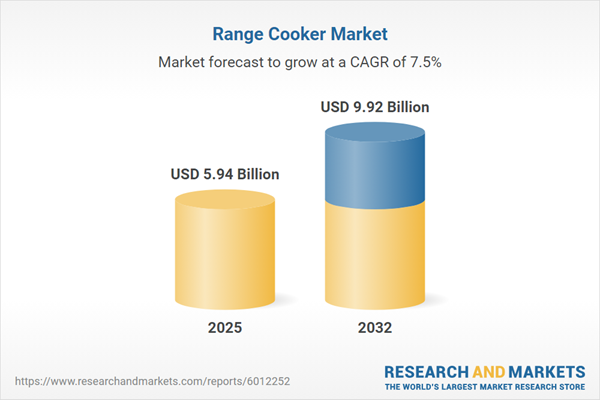Speak directly to the analyst to clarify any post sales queries you may have.
The range cooker market is evolving rapidly as cooking appliances become increasingly central to commercial and residential culinary environments. Market participants face a dynamic landscape shaped by technology, sustainability, and shifting consumer expectations.
Market Snapshot: Range Cooker Market Size and Growth
The global range cooker market reached USD 5.54 billion in 2024 and is projected to grow at a CAGR of 7.53%, attaining USD 9.92 billion by 2032. Demand is driven by the integration of advanced heating technologies and changing preferences within both professional and home kitchens.
Scope & Segmentation of the Range Cooker Market
This report offers a comprehensive examination of the range cooker sector, analyzing multiple segmentation categories and geographic regions to ensure actionable insight for industry leaders.
- Product Types: Built-in, freestanding; single and double oven configurations, including slide-in designs for hybrid requirements.
- Fuel Types: Dual fuel, electric, gas—reducing reliance on conventional fuels and promoting energy efficiency.
- Technology: Halogen hobs, induction hobs, radiant heating—enabling faster performance and precise temperature control.
- Number of Burners: Single, double, three, four—addressing varied cooking demands in different settings.
- End User Applications: Residential; commercial segments: hospitality, institutional, restaurants—each with unique feature priority.
- Distribution Channels: Hypermarkets, supermarkets, specialty stores, company-owned websites, eCommerce platforms—serving a spectrum of purchasing preferences and consultation needs.
- Regions Covered: Americas (United States, Canada, Mexico, Brazil, Argentina, Chile, Colombia, Peru); Europe (United Kingdom, Germany, France, Russia, Italy, Spain, Netherlands, Sweden, Poland, Switzerland); Middle East (UAE, Saudi Arabia, Qatar, Turkey, Israel); Africa (South Africa, Nigeria, Egypt, Kenya); Asia-Pacific (China, India, Japan, Australia, South Korea, Indonesia, Thailand, Malaysia, Singapore, Taiwan).
- Major Companies Profiled: LG Electronics Inc., Whirlpool Corporation, AGA Rangemaster Group Ltd., Baumatic, Beko, Belling Ltd., Bertazzoni S.p.A., BSH Hausgeräte GmbH, DeManincor Ltd., Electrolux AB, Fisher & Paykel, Fulgor Milano, Gorenje, Haier Group, Hotpoint Appliances, ILVE S.p.A., Kenwood, Lacanche SAS, Miele & Cie. KG, Officine Gullo, Samsung Electronics, Smeg S.p.A., Stoves plc, Sub‑Zero Group, The Middleby Corporation.
Key Takeaways for Senior Decision-Makers
- Technological advancements—particularly in induction, halogen, and hybrid fuel systems—are transforming design and functionality across the category.
- Smart kitchen ecosystems and IoT-enabled range cookers set new benchmarks for convenience, performance, and after-sales support.
- Sustainability efforts influence product design nationwide, with eco-friendly materials and energy-efficient components now standard expectations.
- Product diversification, compact designs, and customizable modules are expanding adoption in urban and space-constrained settings.
- Brand alliances, partnerships with culinary professionals, and modular upgrades are establishing competitive differentiation in mature and emerging markets.
- Supply chain agility and transparent value communication are key to mitigating policy- or tariff-driven volatility in input sourcing and pricing.
Tariff Impact: Navigating Policy-Driven Market Changes
Recent U.S. tariffs on imported kitchen appliances are increasing input costs for manufacturers reliant on foreign precision modules and specialty materials. These challenges have prompted strategic sourcing shifts, nearshoring considerations, and adjustments to product pricing structures. Manufacturers are countering added expenses by exploring local assembly, material substitutions, and modular approaches that maintain quality while reducing exposure. Downstream, promotional messaging increasingly emphasizes long-term energy savings and enhanced warranties to offset consumer sensitivity to price changes.
Methodology & Data Sources
This analysis draws on a multi-phase research approach, blending initial desk research with secondary industry data. Expert interviews and quantitative data validation from trade bodies, government databases, and proprietary sources ensure the accuracy and depth of insights. Scenario modeling and independent peer review further anchor findings in current industry realities.
Why This Range Cooker Market Report Matters
- Delivers actionable intelligence for optimizing product development, channel strategies, and market entry in the competitive global appliance sector.
- Illuminates the interplay between technology, sustainability, regulatory influences, and changing consumer demands for effective strategic planning.
- Supports C-suite and senior decision-makers with validated, segment-specific insights to guide investments and partnership opportunities.
Conclusion
Stakeholders equipped with these insights can navigate complex supply chains, evolving regulatory frameworks, and rapid technological change. The report provides a clear path forward for sustained competitive advantage in the global range cooker industry.
Additional Product Information:
- Purchase of this report includes 1 year online access with quarterly updates.
- This report can be updated on request. Please contact our Customer Experience team using the Ask a Question widget on our website.
Table of Contents
3. Executive Summary
4. Market Overview
7. Cumulative Impact of Artificial Intelligence 2025
List of Figures
Samples

LOADING...
Companies Mentioned
The key companies profiled in this Range Cooker market report include:- LG Electronics Inc.
- Whirlpool Corporation
- AGA Rangemaster Group Ltd.
- Baumatic
- Beko plc by Arçelik A.Ş.
- Belling Ltd.
- Bertazzoni S.p.A.
- BSH Hausgeräte GmbH
- DeManincor Ltd.
- Electrolux AB
- Fisher & Paykel Appliances
- Fulgor Milano
- Gorenje d.d.
- Haier Group Corporation
- Hotpoint Appliances (UK) Ltd.
- ILVE S.p.A.
- Kenwood Limited
- Lacanche SAS
- Miele & Cie. KG
- Officine Gullo
- Samsung Electronics Co., Ltd.
- Smeg S.p.A.
- Stoves plc
- Sub‑Zero Group, Inc.
- The Middleby Corporation
Table Information
| Report Attribute | Details |
|---|---|
| No. of Pages | 192 |
| Published | October 2025 |
| Forecast Period | 2025 - 2032 |
| Estimated Market Value ( USD | $ 5.94 Billion |
| Forecasted Market Value ( USD | $ 9.92 Billion |
| Compound Annual Growth Rate | 7.5% |
| Regions Covered | Global |
| No. of Companies Mentioned | 26 |









